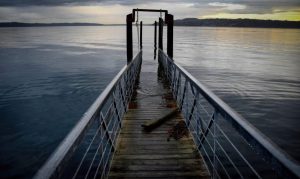July 22, 2022
A new report from the Washington Coastal Resilience Project evaluates the trade-offs between various strategies to manage the impacts of sea level rise
 As sea levels continue to rise, coastal hazards such as flooding and erosion will become increasingly common. According to recent assessments, over 14,000 homes and structures in Washington State — representing a current value of over 8 billion dollars — may be exposed to coastal flooding by 2050. This reality is forcing managers and planners to make difficult decisions about how to best protect their infrastructure and communities.
As sea levels continue to rise, coastal hazards such as flooding and erosion will become increasingly common. According to recent assessments, over 14,000 homes and structures in Washington State — representing a current value of over 8 billion dollars — may be exposed to coastal flooding by 2050. This reality is forcing managers and planners to make difficult decisions about how to best protect their infrastructure and communities.
The Washington Coastal Resilience Project — a collaboration between the state’s Department of Ecology, the University of Washington Climate Impacts Group and Washington Sea Grant — has released a new report that analyzes strategies for managing shorelines as the seas rise. In Sea Level Rise and Management Options for Washington’s Shorelines, the team evaluates the trade-offs associated with four commonly used approaches to preventing damage due to coastal hazards: building hard defensive structures, using soft shore stabilization techniques, using accommodation techniques that decrease the impacts of flooding as it occurs, and removing or avoiding the development of homes and infrastructure from hazardous zones.
“What we do along the shoreline is always about trade-offs, and that is the framework we applied in this report to these four approaches,” says Ian Miller, coastal hazards specialist at Washington Sea Grant and co-author on the report. Coastal decision-makers — such as property owners, community groups and local government officials — already use all of these approaches to manage flooding and erosion.
At the same time, all of these approaches have their relative benefits and drawbacks. The report compares the four strategies in terms of their effectiveness, cost, social implications and ecological implications. For example, while hard armoring — which currently exists along 27 percent of Puget Sound’s shoreline — can effectively reduce risk from coastal hazards, it can be expensive to maintain and can negatively impact intertidal habitats. On the other hand, soft shore stabilization techniques are often less expensive and less ecologically damaging but they may not be effective in some circumstances.
“Homeowners want to protect their property facing increased erosion from coastal storms. So, they turn to hard defenses that negatively impact nearshore habitat,” says report author Nicole Faghin, who recently retired as a coastal management specialist at Washington Sea Grant. “Meanwhile, local governments feel frustrated without adequate language and justification about why these hard defenses may not be the best alternative, both to protect property and the environment in the face of increased sea levels. We produced this report to start that conversation.”
More and more jurisdictions and communities in Washington are starting to add sea level rise to the list of issues with which they need to grapple when deciding what to do on the shoreline. Part of the difficulty in making decisions around coastal management is understanding the timeframe over which these decisions will apply. With the current sea level rise projections, of the four approaches analyzed in the report, one emerged as the clear winner in terms of effectiveness over the long-term: not building structures in at-risk areas in the first place, or moving structures that already exist in these zones. “Based on our analysis, we conclude that all four types of approaches can be effective at reducing risk from coastal flooding, though the duration of that effectiveness varies,” the report authors write. “Only the retreat and avoidance strategies reduce risk in perpetuity as sea level rises.”
Of course, this retreat or avoidance strategy has some major drawbacks as well. “Removing homes or infrastructure from the shoreline is not always easy. There are a variety of challenges communities or individual property owners face when implementing it,” says Faghin. “For example, there may be limited property for moving back. Avoidance approaches, using planning processes like comprehensive planning, can also be politically difficult.”
“Washington is already experiencing coastal hazards we know will get worse as we see more sea level rise. Individual property owners, neighborhood groups and local governments are asking what the right approach may be,” said Sydney Fishman, shoreline planner for the Department of Ecology
“As a result of our research, we concluded two important things: There is no one-size-fits-all answer—there are trade-offs with each approach—and we still have more research to do to support coastal decision-makers and answer their questions,” she said. “Now is the time to start having conversations about sea level rise adaptation because coastal management decisions will take time to research and implement.”
This new report is one of a suite of resources that the Washington Coastal Resilience Project has published to help planners, policymakers and others incorporate sea level rise considerations into their work. This body of work is based on the Washington State sea level rise projections that the team published in 2018. These resources are available on the Washington Coastal Hazards Resilience Network website: https://wacoastalnetwork.com/research-and-tools/slr-resources/
###
Washington Sea Grant, based at the University of Washington, helps people and marine life thrive through research, technical expertise and education supporting the responsible use and conservation of coastal ecosystems. The National Sea Grant College Program is part of the National Oceanic and Atmospheric Administration, U.S. Department of Commerce.
www.wsg.uw.edu.
Join the conversation: @WASeaGrant and Facebook.com/WaSeaGrant.
JUL
2022